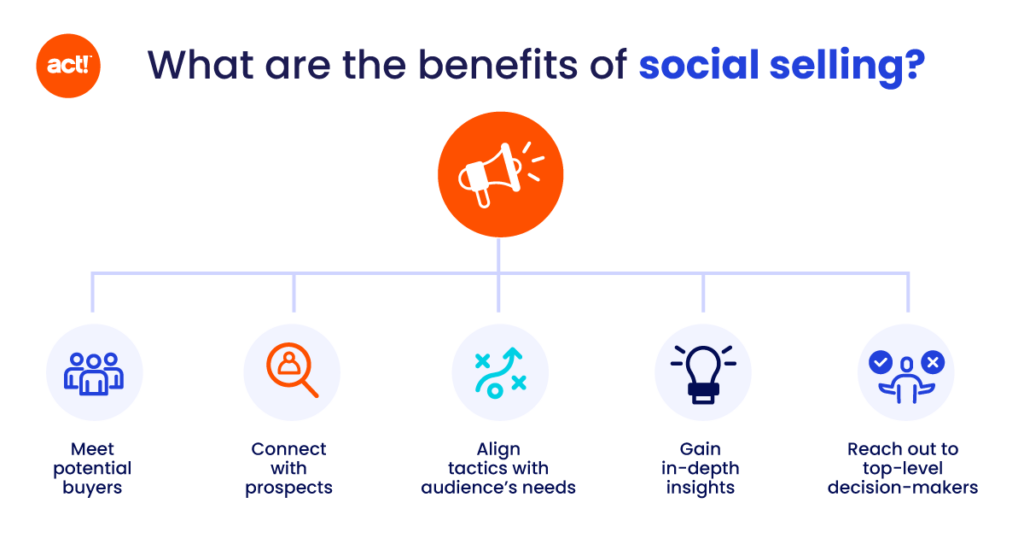
With more than 5 billion users worldwide, social media platforms offer an excellent means for companies to connect with their target audiences. Because they are useful for lead generation and relationship building, social media channels are an indispensable part of any sales strategy for starting and growing a business.
But here’s the thing—selling on social media isn’t just about posting engaging and relevant content now and then. Instead, you need a concrete social selling strategy to connect with the right B2B buyers, build trust, and convert them into paying customers.
In this blog, we’ll take a closer look at the benefits and best practices of social selling.
What is social selling?
Social selling is the technique of using social media platforms to find new prospects, engage with them, and close sales. Successful social selling involves generating and qualifying leads and earning their trust before pitching your product or service. The idea is to build relationships with prospects instead of asking them to purchase right away.
Also, unlike social media marketing, social selling efforts don’t stop at publishing meaningful and traction-worthy content on different platforms.
Of course, social media campaigns play a crucial role in building brand awareness and attracting the right prospects. However, social sales reps and social sellers take things a step forward and engage in one-on-one conversations with these prospects, aiming to build long-term relationships.
What are the benefits of social selling?

First things first—with social selling, you can meet potential buyers where they already are. Whether you want to connect with C-suite executives or entry-level employees, you’ll find them on one social network or another. All you have to do is identify your target audience’s preferred social media channels and become active there.
On the plus side, connecting with prospects on social media is more scalable than going to in-person networking events. It’s more cost-effective, and you get your hands on high-quality leads.
Then there’s the added benefit of aligning your marketing and sales tactics to your audience’s needs. Social sales teams can use social listening tools to stay on top of conversations involving your brand, products, competitors, and the overall industry.
That, in turn, helps you gain in-depth insights into each prospect’s needs and pain points. You can use these insights to personalise your messaging and build a deeper connection with them, helping your salespeople close more deals faster.
It’s also worth keeping in mind that with social selling, you can directly reach out to top-level decision-makers. Engaging with them is far more effective in driving sales than connecting with gatekeepers through traditional sales channels.
Other benefits of selling on social media include:
- Increased brand visibility
- Improved brand reputation and credibility
- Enhanced brand trust and loyalty
- Shortened sales cycles
Choosing the right networks for social selling
It’s necessary to choose the right social media platform, whether it’s to advertise your business or connect with people interested in your offerings. A platform that doesn’t have your audience won’t help your cause.
When it comes to effective social selling, LinkedIn is often the preferred channel for obvious reasons. The platform is a favourite among C-suite executives and is particularly useful for driving B2B sales. Unlike other social networks, many LinkedIn members use the platform to inform business-related decisions.
Also, LinkedIn’s Social Selling Index can be a helpful metric for evaluating the performance of your strategies. Similarly, LinkedIn Sales Navigator is a valuable tool for finding more prospects.
Then there’s X. Formerly called Twitter, X is designed to encourage public discussions. The platform’s search functionalities make it easy to find and jump into relevant conversations. That, in turn, can help establish your reputation as a thought leader and gain the trust of potential customers.
Other social media channels like Facebook, Instagram, and TikTok are generally best for content consumption and entertainment. However, you can still use these platforms to increase brand awareness and reach more prospects.
Keep in mind that there isn’t a well-defined formula to select the right social selling channels. Instead, you must have a deep understanding of your potential customers’ preferred social networks and select the right channel(s) accordingly.
Best practices to get started with social selling
Social selling takes more effort than just posting insightful content on social media. It demands a concrete strategy to identify and connect with the right prospects and move these conversations outside social media to close sales.
If you’re getting started with social selling, the following tips will come in handy to optimise your sales process:
- Build your personal brand: Create impressive profiles on selected social media platforms. Include attention-grabbing details about your expertise and experience. Get endorsements from coworkers and clients, and share top-quality content on your profiles. If you have a team of social sales professionals, make sure they set up attention-worthy social media profiles, too.
- Leverage social listening: Many social media marketing tools also offer social listening features. You can use these to set up alerts for brand, product, and competitor mentions. They can also be used to identify trending hashtags and keywords. That, in turn, will help you chime into relevant discussions and connect with your target audience.
- Harness the power of comments: Check your posts regularly and respond to audience comments with more meaningful insights. It’s also a good idea to comment on your prospects’ posts and strike up a conversation with them. Avoid hard-selling your products/services, though.
- Furnish social proof: Besides posting informative content, consider sharing customer testimonials and success stories. Better still, you could publish a case study or record a podcast about a customer’s experience with your company. It can be an excellent way to build credibility and help prospects understand how your offerings fit their needs.
- Know when to move out of social media: Social networks are ideal for finding and connecting with target customers. But if you want to close a deal, there may be a time when you must take that conversation to another channel like email or phone. Timing is crucial here. If you’ve been communicating with a prospect for a while and they seem interested in your business, ask them whether they’d like to connect on a call for more details. Or better still, suggest an in-person meeting or a product demo to move them closer to a purchase decision.
It’s time to up your social selling game
With social media platforms attracting a vast user base, a social-selling strategy is becoming a must-have for modern businesses. However, selling on social media requires a more nuanced approach than sending a sales pitch in DMs.
Build brand authority and thought leadership by publishing valuable content that resonates with your audience’s needs. Once you have a prospect’s attention, engage in meaningful conversations and help them see the value in your offerings.
A CRM solution like Act! can help you stay on top of the leads generated through social selling. Start your free trial to see the platform in action.







